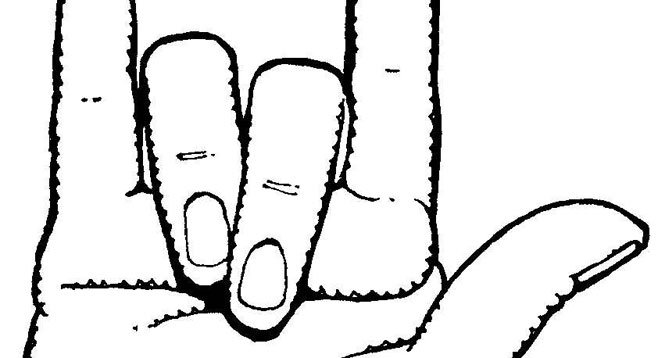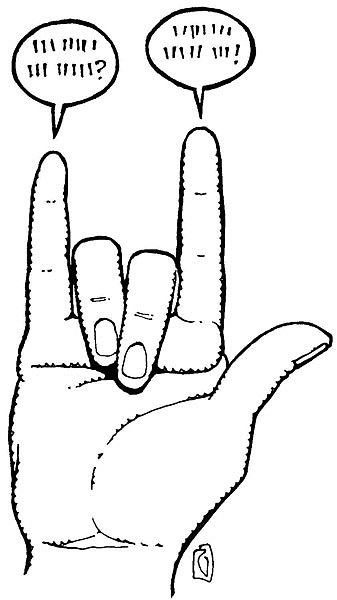 Facebook
Facebook
 X
X
 Instagram
Instagram
 TikTok
TikTok
 Youtube
Youtube

Heymatt:
I have always wondered why some people who use American Sign Language speak words as they sign them, sometimes without making any actual sound. If sign language is intended for deaf people, what is the point in using speech?
— Kyle, CIty Heights

There’s no single answer for this question, but I can shed some light on a few different parts of the problem for you and at least draw a partial conclusion. There are some people, usually members of the “hearing” community, for whom ASL is a second language. For them, the link between speech and sound is so deeply ingrained that it’s hard to disassociate the two things and speak only with the hands. Effectively, they’re translating words into signs as they say them, much the same way as someone learning a second language has to formulate thoughts in his first language before translating them into the second. Fluency occurs when someone learns to think and process information in a new language, removing the intermediary step of silent translation. There’s a whole lot of tricky, structural linguistics from Roman Jakobson, Ferdinand de Saussure, Roland Barthes (among others), but I’ll spare you the college lecture.
Truly fluent ASL speakers involve the face and mouth in signing. “Mouth movements” and other non-manual signs are very different than “mouthed words,” because they are not associated with verbal speech. They’re more like punctuation marks, suffixes, prefixes, contractions, and all the subtle parts of speech that give nuance to conventional language. Deaf (and ably hearing) ASL speakers capable of fully expressing themselves via sign use much more than their hands. Facial expressions and gestural signifiers aren’t limited to sign language by any means. Just watch someone with an expressive set of eyebrows talk. If you pay attention, you’ll start to see linguistic patterns emerge in just about anything. Sign languages are still being studied and theorized over because, while they operate much like conventional languages, they aren’t identical in every aspect. Those key differences get linguists all hot and bothered, sparking no end of saucy, academic debates.
Heymatt:
How come we always refer to “South Florida” when conventions for other states and places dictate the use of “southern?” I’m thinking of how you would say “Southern California” or “Southern Illinois.” Even the South itself is referred to as the “Southern United States” when you use “south” adjectivally. “South Florida” is the only exception I can think of. What gives?
— via voicemail
Heymatt:
How come I have never heard of anyone with the last name of South? There are plenty of Wests and Norths. East is a bit more rare. It usually serves as the foundation for a suffix: Clint Eastwood, George Eastman, etc., Poor old South is barren in the name game. Have you or your elves heard of anyone with the surname of South?
— Jay, via email
As far as South and Southern Florida are concerned, both terms are equally valid and nobody should hem and haw over your use of either. The New York Times is good enough to keep accurate records dating back to the middle of the 19th Century. Up until the 1960s, “South Florida” and “Southern Florida” appeared with roughly equal frequency in the world’s biggest newspaper, each one being used a couple of hundred times per year. From the 1960s until today, use of “Southern Florida” steadily drops off and the familiar “South Florida” gains an overwhelming majority. Why this idiosyncrasy got locked into speech around the middle of the 20th Century is anybody’s guess. My theory is that the spread of television gave verbal communication an edge over the written word and formerly localized terms became more widespread following their use in mass media. Lots of other things are like this. After all, why “upstate New York?” One thing they say about Florida is that “the further north you go, the further south you are.” What that means is that the northern part of the state is more socially in tune with the culture of the Southern United States. That is to say, you’re more likely to see Confederate flags, sweet tea, and pronounced drawls in Tallahassee than in Miami.
As far as people’s names go, West is the only one of the cardinal directions to break into the top 1000 surnames in the United States during the past couple of U.S. censuses. It actually did well, almost cracking the top 100! North, South, and East aren’t even on the list of the top 1000 as of the 2000 census. Would you believe Osborn, Bright, and Bolton all trump the directional names? I found census records from 1990 that ranked every single surname in the U.S. North is #1797, East is #2620, and South is the big loser at #2723...only slightly less common than Troutman. Ouch.
In case this all left you wondering, at the very bottom of the list, ringing in at #88799, is the least common surname (that appears with sufficient frequency as to be statistically significant) in the entire United States: Aalderink.


Heymatt:
I have always wondered why some people who use American Sign Language speak words as they sign them, sometimes without making any actual sound. If sign language is intended for deaf people, what is the point in using speech?
— Kyle, CIty Heights

There’s no single answer for this question, but I can shed some light on a few different parts of the problem for you and at least draw a partial conclusion. There are some people, usually members of the “hearing” community, for whom ASL is a second language. For them, the link between speech and sound is so deeply ingrained that it’s hard to disassociate the two things and speak only with the hands. Effectively, they’re translating words into signs as they say them, much the same way as someone learning a second language has to formulate thoughts in his first language before translating them into the second. Fluency occurs when someone learns to think and process information in a new language, removing the intermediary step of silent translation. There’s a whole lot of tricky, structural linguistics from Roman Jakobson, Ferdinand de Saussure, Roland Barthes (among others), but I’ll spare you the college lecture.
Truly fluent ASL speakers involve the face and mouth in signing. “Mouth movements” and other non-manual signs are very different than “mouthed words,” because they are not associated with verbal speech. They’re more like punctuation marks, suffixes, prefixes, contractions, and all the subtle parts of speech that give nuance to conventional language. Deaf (and ably hearing) ASL speakers capable of fully expressing themselves via sign use much more than their hands. Facial expressions and gestural signifiers aren’t limited to sign language by any means. Just watch someone with an expressive set of eyebrows talk. If you pay attention, you’ll start to see linguistic patterns emerge in just about anything. Sign languages are still being studied and theorized over because, while they operate much like conventional languages, they aren’t identical in every aspect. Those key differences get linguists all hot and bothered, sparking no end of saucy, academic debates.
Heymatt:
How come we always refer to “South Florida” when conventions for other states and places dictate the use of “southern?” I’m thinking of how you would say “Southern California” or “Southern Illinois.” Even the South itself is referred to as the “Southern United States” when you use “south” adjectivally. “South Florida” is the only exception I can think of. What gives?
— via voicemail
Heymatt:
How come I have never heard of anyone with the last name of South? There are plenty of Wests and Norths. East is a bit more rare. It usually serves as the foundation for a suffix: Clint Eastwood, George Eastman, etc., Poor old South is barren in the name game. Have you or your elves heard of anyone with the surname of South?
— Jay, via email
As far as South and Southern Florida are concerned, both terms are equally valid and nobody should hem and haw over your use of either. The New York Times is good enough to keep accurate records dating back to the middle of the 19th Century. Up until the 1960s, “South Florida” and “Southern Florida” appeared with roughly equal frequency in the world’s biggest newspaper, each one being used a couple of hundred times per year. From the 1960s until today, use of “Southern Florida” steadily drops off and the familiar “South Florida” gains an overwhelming majority. Why this idiosyncrasy got locked into speech around the middle of the 20th Century is anybody’s guess. My theory is that the spread of television gave verbal communication an edge over the written word and formerly localized terms became more widespread following their use in mass media. Lots of other things are like this. After all, why “upstate New York?” One thing they say about Florida is that “the further north you go, the further south you are.” What that means is that the northern part of the state is more socially in tune with the culture of the Southern United States. That is to say, you’re more likely to see Confederate flags, sweet tea, and pronounced drawls in Tallahassee than in Miami.
As far as people’s names go, West is the only one of the cardinal directions to break into the top 1000 surnames in the United States during the past couple of U.S. censuses. It actually did well, almost cracking the top 100! North, South, and East aren’t even on the list of the top 1000 as of the 2000 census. Would you believe Osborn, Bright, and Bolton all trump the directional names? I found census records from 1990 that ranked every single surname in the U.S. North is #1797, East is #2620, and South is the big loser at #2723...only slightly less common than Troutman. Ouch.
In case this all left you wondering, at the very bottom of the list, ringing in at #88799, is the least common surname (that appears with sufficient frequency as to be statistically significant) in the entire United States: Aalderink.
Comments